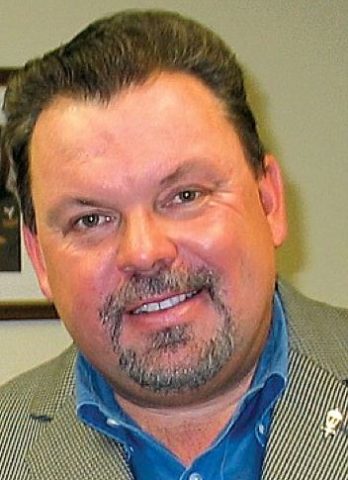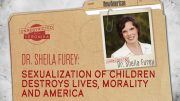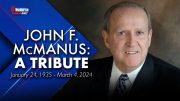
For Thomas Kinkade, however, suffusing his canvas with light is more than just an artistic technique to invite people into his beautiful, idealized world; it is an expression of his faith in Jesus Christ as the “light of the world.”
In a special Christmas interview with THE NEW AMERICAN, Mr. Kinkade explained his Christian worldview and how it relates to his work as an artist. “Each of us is a small part of God’s plan,” he noted. “I’m a small part. I create paintings that are being used by God…. My work is a direct, front-line ministry. It goes into people’s homes and hearts who are unchurched. Many of the people who love my work have never heard the Gospel, and God can use me and these paintings to reach them.”
God, Family, Country
In addition to unabashedly proclaiming his faith — whether in his written “messages” that accompany his paintings, in his talks at exhibits, or in media interviews — Kinkade also is known and loved for his outspoken commitment to family and country. “I do stand for family, marriage, and home, and I do believe in patriotism and this great country,” he says.
Thomas Kinkade lives and works in the hills above Silicon Valley with his wife Nanette and their four daughters Merritt, Chandler, Winsor, and Everett. Kinkade often pays loving tribute to his family by including them, or hiding their names or initials, in his paintings. His beautiful “Paris, City of Lights,” he says, could be titled “The Kinkade family in Paris.” In that painting, he “set the time machine back a few decades and included myself (in the red beret), painting the fabulous Café Nanette. The real Nanette, holding baby Chandler, hails a cab, while our oldest daughter Merritt looks on.”
A typical workday for the artist begins at 6:00 a.m. “I walk from our home through the forest about 60 feet to my studio and begin painting,” he says of the daily routine. “I work until breakfast-time, then come back for breakfast with the girls — that’s a big tradition with us — then pray with them before they go to school. Then I come back to the studio and work throughout the day until dinner time, except for maybe an exercise break or some time with my wife. Sometimes I work in the evenings too, but if I do, the girls usually come over to the studio with me.”
Born in 1958, in Sacramento, California, Kinkade grew up in nearby Placerville, a small town in the foothills of the Sierra Nevadas. His parents broke up when he was very young and his mother was left alone to support Thomas and his brother and sister. “My brother and I always had jobs and worked from a young age,” he says. “We were a real family of prayer. My mom taught us to believe in miracles. She always trusted the Lord and talked about the miracles God worked in her life.”
Kinkade began drawing as soon as he could hold a pencil or crayon, and his mother was his first collector. She decorated the house with his creations. He studied art at the University of California-Berkeley and the Art Center College of Design in Pasadena, then began a stint in Hollywood as a background painter for animated film. The resplendent lighting effects in Kinkade’s idyllic landscapes, seascapes, and cityscapes do credit to the famous 19th century “Luminists” of the Hudson River School, Albert Bierstadt, and Thomas Cole. The influence of Norman Rockwell, Currier & Ives, and other illustrators are also evident in Kinkade’s work.
“I’ve always been drawn to artists who paint for the everyday person,” Kinkade says. “I love the American illustrators. I love Norman Rockwell for that reason; he created paintings that had meaning for real people and wasn’t concerned about what the self-appointed intelligentsia had to say. The so-called art experts might not credit his work as being important, but it was important to real people. And to me, that makes it important. I find the same dynamics at work in my own artistic life. So often I’m at odds with the critical Establishment, which is very anti-Christian and anti-moral.”
Battling the Darkness
The same “critical Establishment” which daily extols and exalts depravity and ugliness, Kinkade notes, will deride his work as irrelevant and worthless. The art “sophisticates” routinely attack his work as “sickeningly sweet,” “saccharine-laced,” “sentimental,” “commercial,” and “unimaginative.”
Is he surprised by the venomous attacks? “I’m not surprised at all,” he says. “You have to expect spiritual warfare whenever you stand up for righteousness or call attention to basic values. It’s just a matter of light battling the darkness. But the light wins every time. You can’t throw enough darkness on light to put it out. Symbolically, I believe that every time that people in the darkness attack me, as I’m attempting to shine God’s light, it just makes the light stronger. It’s fascinating, because I’m trying to create beauty and excellence in my paintings, and ordinary people can see and appreciate that. And they have created a huge backlash against many of my media critics. It is extremely gratifying to me to see that so many people really care and have come to my defense, saying ‘How dare you attack this guy who’s trying to make a difference in the world.’”
Kinkade is not put off by those who dismiss him as “just an illustrator.” “I believe I’ve been put in this position,” he says, “to create a sort of iconography for the masses. Ten million people have my paintings in their homes. And to all these millions of people these paintings provide comfort, joy, hope, meaning, a way of understanding the world, a way of assuring themselves that it’s not all ugliness. And that’s a worthy and high goal. If that means that I’m just an illustrator, then I’m an illustrator of people’s ideals and dreams. And I’m proud of that because what I create are messages of hope, silent messages of hope that go into the homes of people of all faiths and all backgrounds and become a part of their families.”
A Fount of Creativity
What are the sources that spark the ideas for his paintings? The process of creativity is hard to explain, he says, but the inspirations that come to him are never-ending. “I keep a little journal with me at all times — a little sketchbook — and forever am having ideas that seem to pop into my head and spark a creative thought. Maybe something as simple as the way the light shines from a telephone pole — that will give me an idea for assembling a composition. I get ideas everywhere.”
What advice does Thomas Kinkade offer to young artists? “I tell them that first you have to be a person of prayer. Art is a faith profession. You take a white piece of canvas and create something on it that wasn’t there before. Involved in that process is faith. You’ll reach roadblocks and stumbling blocks, points where you falter — when you need to just be at peace and know that God will work all things together for good for those who love Him. So I do that process daily. I pray when I come up against a difficult time in a painting and I say, ‘OK, Lord, you’re just going to have to do a miracle here because I don’t know what to do.’ Inevitably, I feel God’s comfort and His presence. I would say, commit your talents to the Lord, whether it’s painting, singing, writing, or running a business. Everything God has given us is His, so we have to give it back to Him formally, which is what I’ve done. My faith is central to who I am. My faith in Christ is not just a social behavior pattern or membership in a local club or church, it’s a vital part of my survival. I have not been able to find a way to be creative apart from Christ. Apart from Him all you do is exalt the flesh, and that’s not creativity.”
The Light of Liberty
In the wake of the September 11th terrorist attacks on New York City and Washington, D.C., Kinkade painted “The Light of Freedom” to raise funds for the emergency disaster relief efforts and to draw America’s attention back to “foundational values.”
“I woke up on the 12th frustrated and angry like most people,” he recounted. “I picked up a paintbrush and in record time — 36 hours — had finished it.” The painting’s dramatic sky, he points out, is a backdrop to the center portrayal of the American flag representing unity. Cumulus clouds depict God’s blessing. The eagle reflects both military and spiritual strength. The Statue of Liberty stands for freedom, while the New York skyline represents a creative center of prosperity and its people.
“With this painting,” he said, “I wanted to remind people that, as a nation, we have been so tremendously blessed by God and that we have so much for which to be thankful.”
This article originally appeared in the December 17, 2001 issue of The New American.



